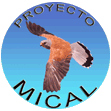| LESSER KESTREL PROYECT IN TRUJILLO
Lesser Kestrel (falco XXX) is a species which is already extinct in a number of countries and is currently suffering a severe backwards movement in the whole of the Iberian Peninsula. In Trujillo, a village in the province of Cáceres, the population of Lesser Kestrels or “micales” as they are most popularly known in Trujillo, suffers from several common problems such as the loss of their feeding habitat due to the changes and abandonment of the crops, to the loss of feeding resources owing to the use of insecticides and above all, due to the forced change of nesting sites of the colonies because of the settlement of other birds such as crooks and pigeons towards the bullring, as well as the disturbances caused by humans consisting in the closures of their niches and holes on the walls and the restorations of the roofs and the consequent loss of habitat under the roof tiles, place favoured by this species.
Lesser Kestrel is a bird of prey, a small urban falcon whose length ranges between 27 and 33 centimetres and its wingspan between 58 and 74 centimetres having a weight of about 150-180 grams. The male is smaller than the female, and has bluish head, reddish brown mantle and bluish grey tail. Underneath (belly and flank) is reddish tawny with speckled black.
Females and juveniles have reddish brown head and back speckled in dark brown as well as wings and tail. Underparts are creamy finely streaked with brown getting more intense towards the breast. The throat is pale. There is a wide subterminal dark brown stripe in the tail with a fine white edge, being the wing tip a bit darker.
Both male and female have bright yellow eye rings and bill brims and orange-yellow feet. The bill is whitish grey getting darker at the tip and becoming lighter towards the base. The iris is brown and the nails are white.
Some differences between lesser kestrel (falco naumanni) and Common kestrel (Falco tinnunculus):
Common kestrel has a bigger size, with black nails while lesser kestrel has pale nails.
Male lesser kestrel has plain and striped rump and nape while in common kestrel they are spotted.
Lesser Kestrel has grey ear coverts while those in the common kestrel are whitish.
The tail in lesser kestrel is plain grey and it has faint stripes in common kestrel.
They feed on small mammals, grasshoppers, crickets, etc. When hunting it usually flies low over the ground hovering to take it s prey either in the air or off the ground.
They reach Trujillo from Africa during the month of August. The first to arrive are the males and about two weeks later females start to appear starting to take the nooks or niches in palaces and manor houses such as the “Casa de Escobar”· and some other roofs in the town centre. There is also an important colony in San Francisco Church, but the most numerous colonies can be found in the bullring. The mating starts in April and by the second week of June we can already see the hatchlings which go out to sunbathe or enjoy the preys brought by their parents.
In the middle of July Lesser Kestrel start to move to sleeping sites outside the town to later start the journey back to tropical Africa to winter there.
Lesser kestrel has been regarded as a species sensitive to the alteration of its habitat in Extremadura (CREA). The hunting law sanctions with a fine of 601 euros for the killing of a specimen or the destruction of nests or eggs. Selling, importation or exportation of this species is forbidden as well as the hunting, exhibition or usage of poison, possession, traffic and trading with lesser kestrel specimens.
Our behaviour towards this species is basic to help them they evolve successfully so that in a near future it may stop being a menaced species. For that reason we must put into practice a number of measures which have been designed by the Dirección General de Medioambiente (the authorities dealing with environmental issues) which have been included in the Plan for the habitat conservation of Lesser Kestrel in Extremadura.
Some of these measures are the following: to watch and check new nestling sites, avoid disturbances in the nesting sites, report to the police any illegal hunting or nests exploitation.
If also repair works are to be carried out in roofs where some nesting sites exist, they should not start until the brooding season is over (from February to August or September). Similarly nest boxes can be built so as to benefit the lesser kestrel and roofs as well as to avoid covering the holes which don’t affect the structure of the building.
If we happen to find an injured specimen we must place it on its back, cover it with a blanket or cloth and keep its wings folded. We must not feed the bird if the period of time until the bird is retrieved doesn’t excess 12 hours and finally we must place it in a cardboard box with some holes in the lid and call urgently the nearest Recovery Centre, which is this case is “Los Hornos”, phone: 900 351858.
It would be desirable to avoid the following situations as much as possible: the use of insecticides and herbicides, to burn stubble fields and respect the boundaries and ditches as well as to avoid the loss of dry farming crops and reforestations with species which are not autochthonous.
We would really appreciate all kinds of collaborations to help us in the conservation of the lesser kestrel and its habitat.
|
